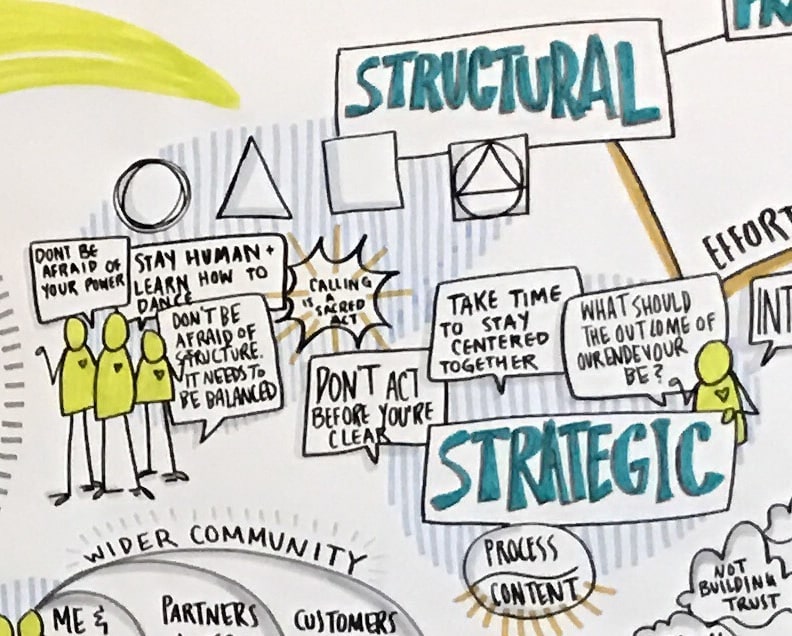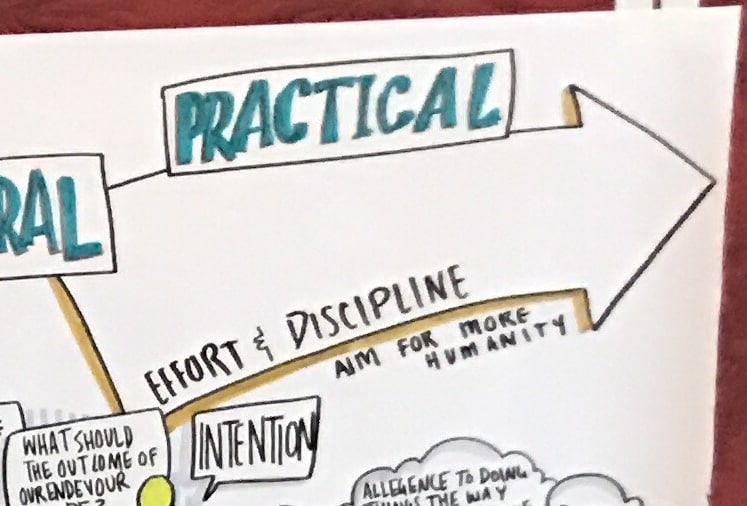
The Groundwork Pattern

The Groundwork Pattern describes the Six Elements of generative collaboration. We believe that regardless of the purpose, content, scale or stakeholders involved, any time we organise, engage or collaborate with others, the elements that determine success are the same. These six elements can be seen as the essential ingredients for working well together as humans.
In order of natural progression the elements are:
- Need and Purpose
- Culture
- Strategy
- Structure
- Action
- Resource
We invite you to share these with your team to bring awareness of the Six Elements into your shared work and to support your practice of collaboration. Each element is important. If one is weak or missing, our capacity for generative collaboration is compromised.
The Groundwork Pattern can be used to support the following:
- Orientation – As a generic map, offering a high-level overview of the elements at play in any collaborative endeavour. The map is not the territory, but it can help us navigate unfamiliar places.
- Preparation – As a planning canvas for individuals, teams, projects, start-ups and for organising meetings or events;
- Operation – As an operating system for self-organisation and to inform ongoing practice.
- Evaluation – As an organisational development/management tool for tracking or reviewing progress in established teams/organisations.

Visual by Bravespace
Need and Purpose
Context is all important. All organising has at its core an impulse to respond to a need. The need is the compelling and present reason for doing anything. Identifying the need helps to manifest purpose and anchor an invitation to collaborate.
Dee Hock defines purpose as the highest collective aspiration of any group, such that one might say “if we could achieve that, my life, our lives and the lives of those we serve will be better”. The purpose is “what ought to be.”
Culture
“Just as every good farmer focuses all his attention on sustaining and enhancing the quality of the soil, every good organisational leader focuses all her attention on sustaining and enhancing the quality of the social field that she is responsible for.”
~ Otto Scharmer
If it is indeed true that “the quality of the field determines the quality of the yield”, then the quality of a collaboration depends on the quality (the health, strength and diversity) of the relationships and the cultural practices within it. Our care and attention is needed to create the conditions that invite strength and diversity and allow everyone within the team to perform at their best. Once this happens then the qualities of collective intelligence and self-organisation emerge more readily. It stands to reason that the Cultural Element is the primary element in determining the quality of collaboration.

Visual by Bravespace
Strategy
“It is not what the vision is, it is what it does that is important.”
~ Peter Senge
The Strategic Element provides the focus and direction for our shared work. Its function is to make visible and engage the dynamic tension between need, purpose and vision. Translating and communicating this into an overall direction creates clarity around which the individual, team and organisation can align. A strong Strategic Element enables us to navigate complexity and be clear when prioritising or making decisions around what is important to the organisation and the work. Vision, Systems Thinking, Creativity, Curiosity, Flexibility, and the ability to work with emergence are important qualities of this element.

Structure
“Self-organising is not a startling new feature of the world, it is the way the world has created itself for billions of years”.
~ Meg Wheatley and Myron Kellner-Rogers
The Structural Element relates to the necessary functions and structures. It’s importance lies in the ability to provide strength and capacity to sustain the collaboration and our ability to take action over time. This is where we begin to see the different parts of the system, how they function and influence each other. Consideration should extend beyond an organisation’s conventional boundaries to include stakeholders where applicable, for example, customers, board members, family members, neighbours, the physical environment etc. By acknowledging these larger system boundaries, we very quickly see how complexity enters our work.
Structure is important on many levels for the success of any team or organisation. Structural elements may include:
- Legal structure
- Organisational patterns/structures (leadership, team structures, roles, responsibilities)
- Process structures (systems and processes including how meetings and time are hosted)
- Physical and energetic space
- IT and Communication structures

Visual by Bravespace
Action
“Ideas without action or inspiration without work are meaningless. Both are needed together.”
~Jos Schuylenburg
The Action Element is all about implementation and learning. It is where strategic decisions, priorities and intentions are translated into practical actions to create movement and results that serve the need and purpose. It is also important that we pay close attention to the impact of our actions to ensure they having the desired effect and moving us closer to our vision? Reflection and Evaluation are important practices for ensuring that we act responsibly and that we can learn going forward.
Action and reflection are an integral part of maintaining and strengthening the collaboration itself. Many factors influence the type of actions needed at a given point in time, however wise actions have a better chance of manifesting when:
i) a team holds a shared awareness of the big picture needs and challenges that brought them together in the first place.
ii) a team is aligned around their individual and shared purposes.
iii) a team is capable of communicating its vision of success and strategic clarity, and
iv) structures, systems and resources exist to implement them.
Resource
“A little thought and kindness are often worth more than a great deal of money”
~John Ruskin
The Resource Element focuses on the resources and inputs required to sustain the work, the collaboration and the well-being of individuals within it. Resources can come in both energetic forms (measured qualitatively) and economic forms (measured quantitatively). The key to this element is that resources should be hosted consciously, regardless of the nature of the collaboration they serve. Nothing damages relationships more effectively than unconsciousness around money and resources. Many of us learn this the hard way.
